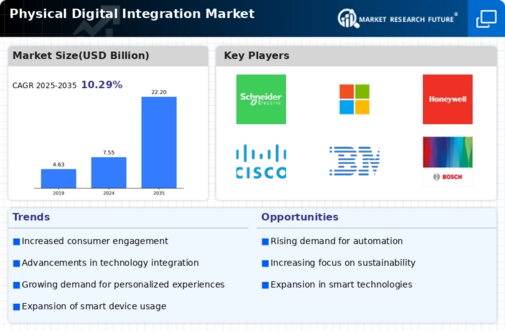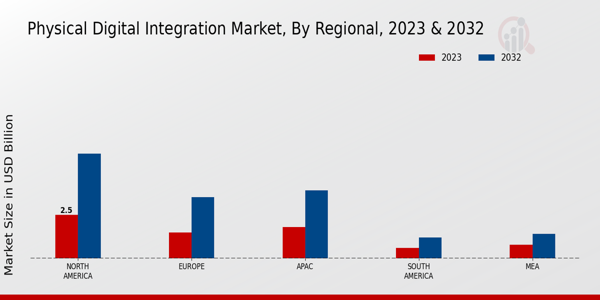Technological Advancements
The Global Physical Digital Integration Market Industry is experiencing rapid technological advancements, which are pivotal in driving growth. Innovations in Internet of Things (IoT), artificial intelligence, and machine learning facilitate seamless integration of physical and digital systems. For instance, smart sensors and devices enable real-time data collection and analysis, enhancing operational efficiency across various sectors. As organizations increasingly adopt these technologies, the market is projected to reach 7.55 USD Billion in 2024, with expectations of further growth as these technologies evolve. This trend indicates a shift towards more interconnected systems, potentially revolutionizing traditional business models.
Rising Consumer Expectations
In the Global Physical Digital Integration Market Industry, rising consumer expectations are influencing businesses to adopt integrated solutions. Consumers increasingly demand personalized experiences and seamless interactions across digital and physical platforms. Retailers, for instance, are leveraging integrated systems to provide omnichannel experiences, allowing customers to transition smoothly between online and in-store shopping. This shift is driving companies to invest in technologies that enhance customer engagement and satisfaction. As a result, the market is likely to grow at a CAGR of 10.29% from 2025 to 2035, reflecting the importance of meeting evolving consumer demands.
Increased Demand for Automation
The Global Physical Digital Integration Market Industry is witnessing a surge in demand for automation across industries. Businesses are increasingly recognizing the benefits of automating processes to improve efficiency, reduce costs, and enhance productivity. For example, manufacturing sectors are integrating robotics and automated systems to streamline operations and minimize human error. This growing inclination towards automation is expected to contribute significantly to the market's expansion, with projections indicating a market size of 22.2 USD Billion by 2035. The potential for automation to transform operational frameworks suggests a robust future for the integration market.
Government Initiatives and Support
Government initiatives play a crucial role in the Global Physical Digital Integration Market Industry by promoting the adoption of integrated technologies. Various governments are implementing policies and funding programs to encourage innovation and digital transformation across sectors. For example, initiatives aimed at enhancing smart city infrastructure are driving the integration of physical and digital systems in urban environments. Such support not only fosters technological advancements but also stimulates economic growth. The ongoing governmental focus on digital integration is expected to significantly impact market dynamics, facilitating a more interconnected global economy.
Emerging Markets and Global Expansion
The Global Physical Digital Integration Market Industry is poised for growth in emerging markets, where digital transformation is gaining momentum. Countries in Asia-Pacific and Latin America are increasingly investing in integrated solutions to enhance their competitive edge. For instance, businesses in these regions are adopting digital technologies to improve supply chain management and customer engagement. This trend is likely to contribute to the overall market growth, as these regions are projected to witness substantial investments in digital infrastructure. The expansion into emerging markets presents a significant opportunity for companies operating within the integration space.

























Leave a Comment